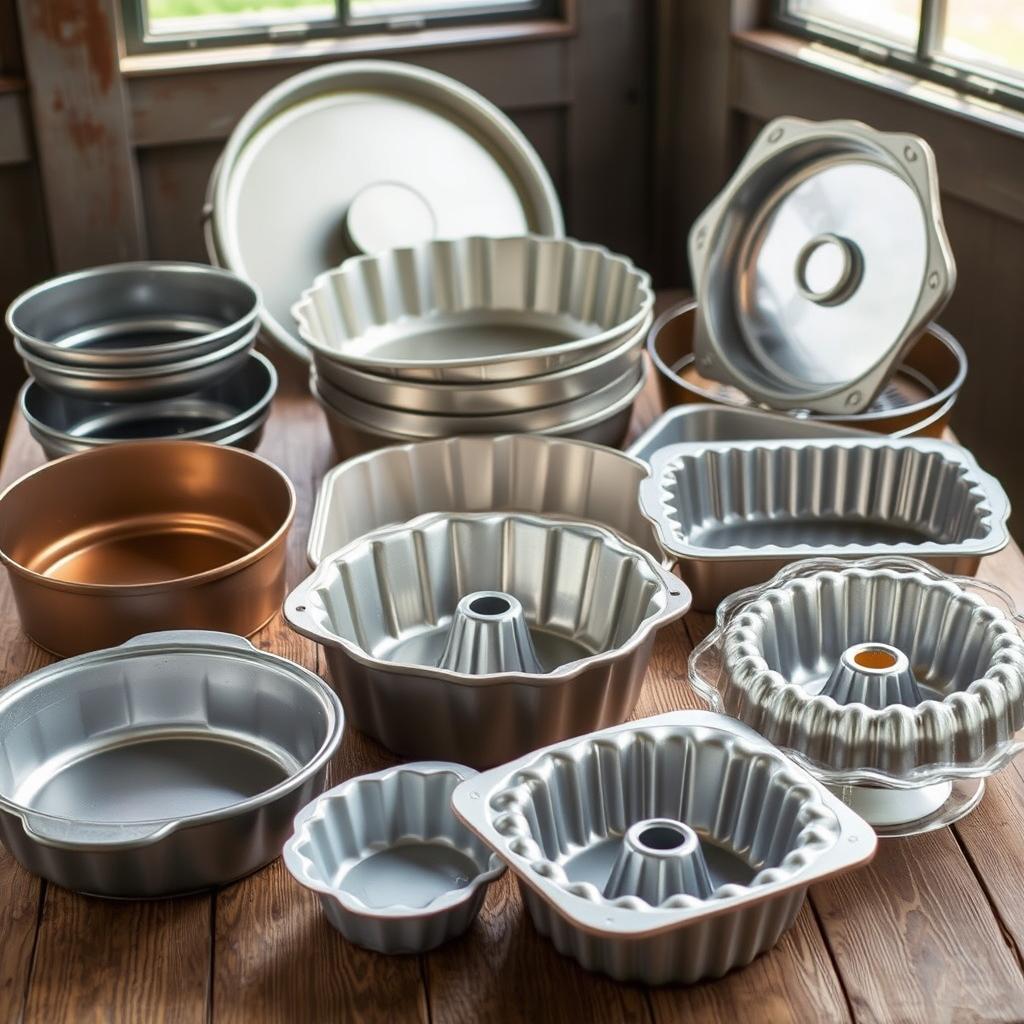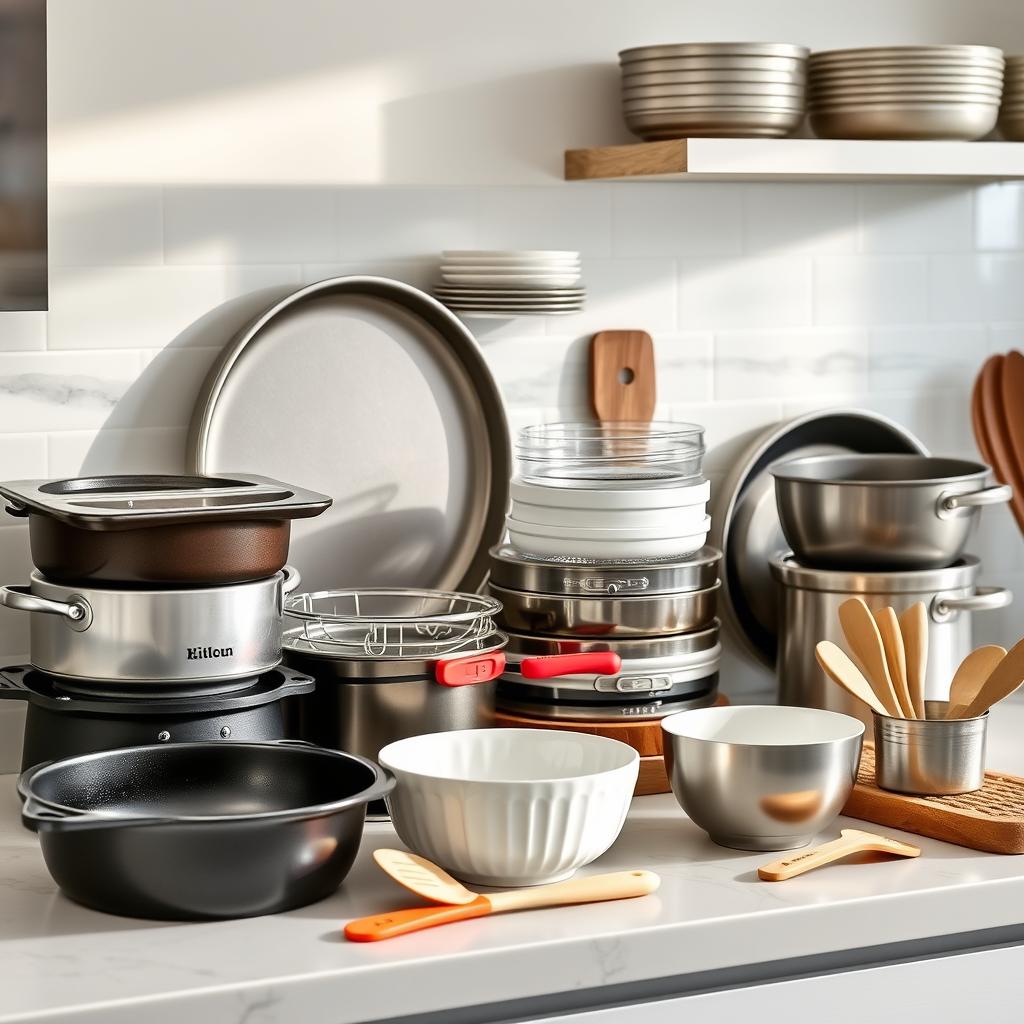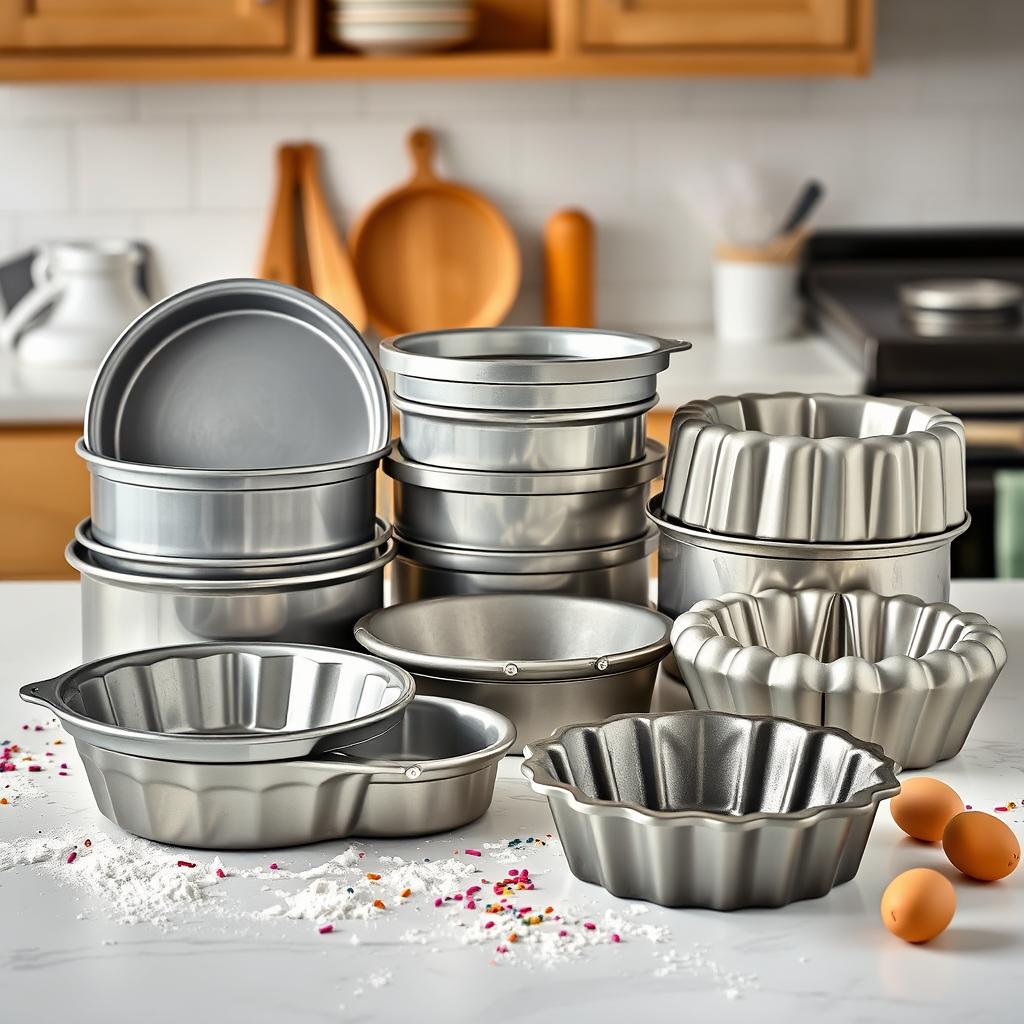As a passionate home baker, I love the joy of pulling a perfectly baked cake from the oven. Its aroma fills the air, and its texture melts in your mouth. But to get those professional-level results, you need more than a great recipe. It’s all about choosing the right cake pan.
Table of Contents
In this guide, I’ll share my expertise on the different types of baking pans. I’ll cover their unique features and essential tips. These will help you master the art of bakeware and create cakes that are truly show-stopping.
Key Takeaways
- Explore the diverse range of cake pans available, including traditional metal options and modern silicone alternatives.
- Understand the essential features that define quality bakeware for consistent and reliable results.
- Learn how to choose the perfect cake tin for your recipe, considering factors like size, material, and shape.
- Discover the pros and cons of non-stick surfaces and master specialized techniques for using springform and Bundt pans.
- Gain valuable insights on proper care and maintenance to extend the lifespan of your baking pans.
Understanding Different Types of Cake Pans
Choosing the right cake pan is key to baking a perfect cake. You can pick from metal pans or silicone bakeware. Each has its own benefits for making delicious desserts.
Traditional Metal Pans
Aluminum pans have been a favorite for many years. They bake cakes evenly and reliably. Their strong build and simple design make them great for many recipes.
Modern Silicone Options
Silicone bakeware is now popular among home bakers. It’s flexible and non-stick, making cakes easy to remove and clean. Plus, it’s light and dishwasher-safe, perfect for busy bakers.
Specialty Cake Molds
For creative bakers, there are many specialty cake molds. You can find Bundt pans with designs or silicone molds in shapes like flowers or animals. These molds help make cakes that wow everyone.

“The right pan can make all the difference in the success of your cake. Explore the options to find the perfect vessel for your baking masterpiece.”
Essential Features of Quality Bakeware
Creating delicious cakes depends a lot on your baking tools. High-quality kitchen tools and baking equipment are key. They ensure even heat and a non-stick surface, leading to professional-grade results at home.
Heat Conductivity
A good baking pan spreads heat evenly. Look for aluminum or stainless steel pans. They help your cakes bake perfectly, avoiding uncooked or overcooked spots.
Durability and Longevity
Quality bakeware lasts long, handling kitchen demands well. Choose pans made from strong, durable materials. They should not warp or degrade with use and storage.
Non-Stick Surfaces
A good non-stick coating makes cakes easy to remove and cleaning simple. Look for pans with durable, long-lasting non-stick finishes. These should not scratch or peel off easily.
| Feature | Importance | Top Materials |
|---|---|---|
| Heat Conductivity | Ensures even baking and prevents hot spots | Aluminum, Stainless Steel |
| Durability | Withstands regular use and extends pan lifespan | Heavy-gauge Metal, Silicone |
| Non-Stick Surface | Facilitates easy release and cleanup | PTFE, Ceramic, Silicone |
Focus on these key features when picking your baking gear. You’ll make delicious cakes and baked goods every time.

Choosing the Right Cake Pan for Your Recipe
Choosing the right cake pan is key to baking success. Whether you’re making a round layer cake or a square sheet cake, the right pan size, material, and shape are crucial. Let’s explore the important factors to consider for the perfect cake pan.
Pan Size Considerations
The size of your cake pan greatly affects the outcome. A pan that’s too small can overflow, while a too-large pan might make the cake thin and flat. Always check the pan size recommended in the recipe instructions.
Material Selection Guide
Cake pans are made from various materials, each with its own benefits. Traditional metal pans are durable and heat evenly, while modern silicone options are easy to clean and release. Think about heat conductivity, non-stick properties, and durability when choosing your pan.
Shape and Design Factors
The shape and design of your cake pan also matter. Round cake pans are great for layer cakes, and square cake pans are ideal for sheet cakes and brownies. Specialty baking accessories, like Bundt pans or heart-shaped molds, can add a special touch to your creations.
By considering these factors, you’ll find the perfect cake pan for your recipe. This will help you achieve amazing results every time you bake.
Non-Stick Surfaces: Pros and Cons
Choosing non-stick pans can change the game in baking. These surfaces make food release easy and cleaning simple. But, like any kitchen tool, they have their own good and bad sides.
The main plus of non-stick pans is how they prevent food from sticking. This makes taking out baked goods like cakes or silicone mold creations a snap. It saves time and keeps delicate desserts intact. Plus, they often need less oil or butter, which is great for those watching their health.
However, non-stick coatings can wear off with time, especially with metal utensils or harsh cleaners. This can make the pan less effective and lead to sticking issues. It’s key to follow the maker’s care tips to keep your non-stick baking dish in top shape.
| Pros of Non-Stick Pans | Cons of Non-Stick Pans |
|---|---|
| Easy food release | Coating can wear down over time |
| Reduced need for oil or butter | Potential health concerns with some coatings |
| Simplified cleaning process | Limited heat tolerance compared to metal pans |
| Preserves delicate baked goods | Requires careful maintenance and handling |
When picking non-stick pans for baking, consider the good and bad. Choose what works best for you and your cooking style. With the right care, you can enjoy their benefits without the downsides.
Mastering Springform Pan Techniques
Springform pans are key for bakers, offering endless possibilities. They’re perfect for cheesecakes and deep-dish pies. We’ll cover how to use them, care for them, and share great recipes.
Assembly and Usage Tips
Assembling a springform pan is crucial for success. Lock the base and sides tightly to avoid leaks. Grease it well to make release easy and baking even.
Be careful not to overfill the pan. Place it in the oven with enough space for even heating.
Maintenance and Care
- Wash springform pans by hand with mild detergent and warm water. Avoid the dishwasher to keep the non-stick coating.
- Dry the pan well before storing to prevent rust or color change.
- Store the pans safely, with the latch open to avoid warping.
- Check the latch often and replace it if needed for a tight seal.
Best Recipes for Springform Pans
Springform pans are great for tall, rich desserts. Creamy cheesecakes and flourless chocolate cakes look and taste amazing. They’re also perfect for deep-dish quiches and savory pies.
“A springform pan is a baker’s best friend, unlocking a world of culinary creativity.”
Bundt Pan Basics and Decorative Molds
Discover the secret to making stunning cakes with Bundt pans and decorative molds. These tools let you create more than just round cakes.
Bundt pans have a unique ring shape. They are perfect for bakers who want to make intricate cakes. You can find many shapes, from classic to fancy designs, to impress your guests.
Decorative cake molds add a new level of creativity. They come in shapes like Bundt, flowers, or patterns. These molds help you make cakes that look like art.
Preparing Bundt Pans and Decorative Molds
To bake successfully with these pans, prepare them well. Grease and flour the pan, especially the details. This prevents the cake from sticking and makes it easy to remove.
Using silicone molds is even easier. Just a little non-stick spray or oil is needed. Their design makes greasing and flouring unnecessary.
Unlocking the Potential of Bundt Pans and Decorative Molds
- Try different cake batters and fillings for unique tastes.
- Add drizzles, glazes, or powdered sugar for a pro look.
- Pair Bundt cakes with fresh fruit, nuts, or crumbles for texture.
- Decorate with edible flowers, sprinkles, or other elements to show off your skills.
Explore the world of bundt pans, cake molds, and silicone baking molds to improve your baking. With practice and these tools, you’ll make cakes that wow everyone.
Proper Care and Maintenance of Your Cake Pan
Bakeware is a big investment for anyone who loves to bake. Taking good care of your cake pans is key to making them last long. This ensures they keep giving you great baking results for years. Let’s look at how to clean, store, and care for your bakeware, kitchen tools, and baking equipment right.
Cleaning Methods
Cleaning your cake pans right is the first step to making them last. Always clean them well after each use to get rid of stuck-on food. Let the pan cool down first, then use a soft soap and warm water to clean it. Don’t use rough sponges or steel wool, as they can harm the non-stick coating or make the metal dull.
If there are tough stains, soak the pan in warm water with baking soda or vinegar. Then, scrub it gently.
Storage Solutions
Storing your bakeware right is just as important as cleaning. Don’t stack heavy things on your pans, as they might warp or dent. Instead, store them standing up, either on a rack or in a special organizer for bakeware. If you must stack them, put parchment paper or a clean towel between each pan to avoid scratches.
Extending Pan Lifespan
To make your kitchen tools and baking equipment last longer, here are some tips:
- Don’t change the temperature of your pans too fast, like putting a hot pan in cold water. This can cause them to warp or crack.
- Use silicone, wood, or plastic utensils when baking to avoid scratching the non-stick surface.
- Don’t use metal scouring pads or harsh cleaners, as they can wear away the non-stick coating over time.
- Check your pans often for any wear and tear. Replace them if needed to keep baking well.
By following these easy tips for cleaning, storing, and caring for your bakeware, you can make it last longer. This way, you’ll keep getting great baking results for many years.
Common Cake Pan Problems and Solutions
Baking can be a joy, but it comes with its own set of challenges. Issues with baking pans and cake tins are common. Knowing how to solve these problems can lead to better baking results.
Sticking is a big problem. Cakes that won’t come out of the pan can be frustrating. To avoid this, grease and flour your non-stick pans well before adding batter. You can also use parchment paper for extra protection.
- Uneven baking is another issue. It might be due to hot spots in your oven or a poorly insulated pan. To fix this, rotate your pan halfway through baking. Also, use an oven thermometer to check the temperature.
- Warping is a problem with baking pans, especially with sudden temperature changes. To stop warping, don’t put hot pans on cold surfaces. Let them cool down completely before washing.
By tackling these common problems and using the right solutions, you can have a better baking experience. This is true for your favorite cake tins and non-stick pans.
“The key to perfect cakes is not just the recipe, but the right tools for the job.”
Professional Baking Tips for Perfect Results
Getting perfect cakes and pastries is more than just a recipe. Professional bakers use expert techniques for flawless results. These include precise temperature control and careful greasing methods.
Temperature Control
Controlling the temperature is key for even baking. Use a reliable oven thermometer to check your oven’s accuracy. Avoid opening the oven door too often to prevent temperature drops.
Greasing Techniques
Greasing pans well is crucial to prevent sticking. Use butter, shortening, or non-stick spray to coat the pan. For delicate cakes, add parchment paper or silicone mats for extra protection.
Even Baking Methods
- Rotate pans halfway through baking for even heat.
- Use an oven thermometer to keep the temperature steady.
- Place pans in the oven’s center for better airflow.
By following these tips, you can make your cakes and pastries perfect. Mastering temperature, greasing, and even baking will lead to delicious results every time.
Innovative Baking Pan Trends
The world of baking is always changing. Cake pans and bakeware are getting new designs and materials. This makes home baking exciting and diverse.
Silicone bakeware is a big hit now. It’s flexible, non-stick, and easy to use. You can make cool shapes and designs with it. Plus, it’s durable and easy to clean.
There’s also a big demand for dessert molds and cake molds. You can find molds in all sorts of shapes, like flowers and animals. This lets bakers get creative and impress their guests.
These trends are not just about looks. They also make baking easier and more versatile. Modern pans have features like multiple compartments and dual uses. This helps bakers make more kinds of treats with less effort.
“The future of baking is all about pushing the boundaries and embracing new technologies that make our lives in the kitchen easier and more enjoyable.”
The baking world is always getting better. With silicone bakeware, dessert molds, and cake molds, the possibilities are endless. Whether you’re a pro or just starting, these trends will excite and satisfy your taste buds.
Converting Recipes for Different Pan Sizes
Baking cakes is a fun art, but what if you don’t have the right pan size? Don’t worry, you can easily change your favorite recipes to fit the pans you have. Just follow a few simple tips.
Understanding how pan size and batter volume relate is key. Deeper pans hold less batter. So, when scaling a recipe, adjust the ingredients based on the pan size.
- Find your pan’s volume: Measure its width and depth to get its volume in cubic inches. This helps you know how to adjust.
- Change the ingredients: If your pan is smaller, use less of each ingredient. For larger pans, use more.
- Watch the baking time: Smaller pans bake faster, while bigger ones take longer. Check your cake with a toothpick to see if it’s done.
With practice, you’ll get good at changing recipes for your cake pans and baking pans. These tips work for all cake pan shapes. You’ll make delicious cakes every time.
| Pan Size | Volume (cubic inches) | Batter Adjustment | Baking Time Adjustment |
|---|---|---|---|
| 8-inch round | 64 | 100% of recipe | 100% of recipe |
| 9-inch round | 79 | 124% of recipe | 90% of recipe |
| 9×13-inch rectangle | 117 | 183% of recipe | 80% of recipe |
| 10-inch Bundt | 100 | 156% of recipe | 85% of recipe |
“Adapting recipes to different cake pans is a valuable skill for any baker to master. With a little experimentation, you can unlock a whole new world of baking possibilities.”
Conclusion
Discovering the right cake pan is key to baking like a pro at home. You’ve learned about metal pans and silicone options. Each has its own benefits for your baking equipment.
Understanding what makes a cake pan great is crucial. It doesn’t matter if you’re new to baking or have years of experience. Trying out different bakeware can lead to new ideas and skills.
Don’t hesitate to try out various cake pans to find your favorites. With the right tools and practice, your baking will impress everyone. You’ll make your homemade treats stand out.
Explore Related Recipes and Tips
To enhance the article “Essential Cake Pan Guide: Types and Tips for Baking”, here are some suggested internal linking opportunities using related content from Guides Recipes:
- Easy Gluten-Free Vanilla Cake Recipe That’s Delicious
Perfect for testing out your new cake pans, this recipe ensures a delightful gluten-free treat that pairs well with Bundt or round pans. - White Chocolate Cake Gluten-Free Recipe: Easy and Delicious
Experiment with specialty cake molds or springform pans to create this visually stunning dessert. - Easy Peach Cobbler Recipe with Cake Mix in 5 Steps
This cobbler recipe is ideal for testing the heat conductivity of your favorite baking dish or rectangular pan. - Boston Cream Cake Recipe: Classic Homemade Dessert
Learn how to make this layered masterpiece using durable and non-stick round pans for perfect results. - Make a Perfect Hello Kitty Cake at Home
Dive into decorative molds and creative cake shapes by following this playful and engaging guide.
FAQ
What are the different types of cake pans available?
There are many types of cake pans out there. You can pick from metal pans, silicone pans, or specialty molds. Metal pans are durable and classic. Silicone pans are flexible and non-stick. Specialty molds let you make cakes in unique shapes.
What features should I look for in quality bakeware?
Look for pans that conduct heat well, are durable, and have a non-stick surface. These features help your cakes bake evenly and release easily. They also make your pans last longer.
How do I choose the right cake pan for my recipe?
Think about the pan size, material, and shape when picking a pan. Consider the recipe’s size, baking time, and how you want the cake to look. This will help you find the perfect pan.
What are the pros and cons of non-stick cake pans?
Non-stick pans are great because they make cakes easy to remove and clean. But, they need special care to keep the non-stick surface working well.
How do I use a springform pan correctly?
Springform pans need special care. Learn how to put them together right, release the cake, and keep them in good shape. This is especially important for cheesecakes and deep-dish pies.
What are the benefits of using a Bundt pan?
Bundt pans make cakes with a beautiful hole in the middle. They let you bake cakes that look amazing and impress everyone.
How do I properly care for and maintain my cake pans?
To keep your pans in great shape, clean them right, store them well, and follow some maintenance tips. This way, your pans will last for many years of baking.
How can I troubleshoot common cake pan problems?
If your cakes stick, bake unevenly, or warp, there are solutions. Understand why these problems happen and use the right techniques to fix them. Proper preparation and baking methods can help.
What are some professional baking tips for achieving perfect cakes?
To make cakes like a pro, control the temperature, grease the pans right, and bake evenly. Use these expert tips to get consistent, tasty results every time.
What are the latest trends in innovative baking pans?
Check out the latest in baking pans, like advanced silicone molds and multi-functional bakeware. These new products can help you make cakes that look amazing and are unique.
How do I adjust recipes for different cake pan sizes?
To use different pan sizes, adjust the recipe’s ingredients and baking time. This skill lets you use your favorite recipes with any pan you have.

